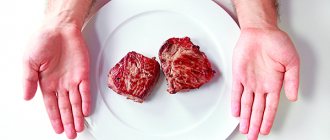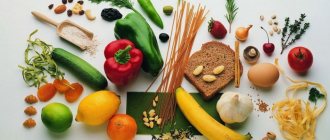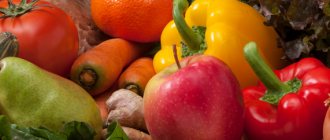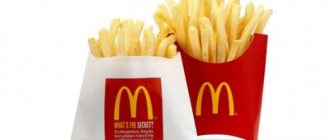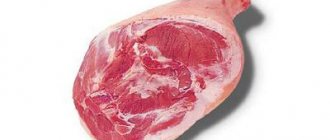Often, in the diet of someone who has followed the difficult path of calorie counting, only boiled chicken breast, rice, cucumbers and other simple foods remain. To calculate the energy value of a dish, just weigh it and enter the numbers in a special application.
A calorie counting guru can prepare a pot of borscht for a week, goulash, salad, cutlets and always know the energy value of a portion. To do this, you need to learn how to calculate how many calories, proteins, fats and carbohydrates are contained in 100 g of a complex dish.
Let's figure out how to do this, using the example of Olivier salad, which is not the most useful, but relevant on the eve of the New Year.
To prepare the salad you will need:
- 300 g boiled potatoes;
- 300 g of Doctor’s sausage;
- 5 eggs;
- 150 g pickled cucumbers;
- 200 g canned green peas;
- 120 g mayonnaise.
Calculation of the mass of the finished dish
Before preparing a dish, each component must be weighed and the results recorded.
Another important figure is the final mass of the finished dish. In this case, it will be 1,345 g, taking into account the fact that one egg of category C1 weighs approximately 55 g. Of course, you can weigh the finished dish only together with the bowl or pan in which it is located. Therefore, determine the mass of the container in advance and subtract this figure from the final one.
Weigh frequently used utensils and record the readings in a notebook. This will come in handy if you forget to find out the mass of an empty bowl.
Norm of proteins, fats and carbohydrates
Let me make a reservation right away that we are only talking about quality food. If we are talking, for example, about carbohydrates, then autonomously we mean complex carbohydrates that are slowly processed by our body. Wheat rolls are also carbohydrates and you can also reach your daily requirement with them. But, most likely, these buns will gradually turn you into a bun.
So, there is a generally accepted BJU ratio at which the human body feels good and does not experience metabolic stress.
1). This is the standard average rate of BZHU (indicators can vary within 10%):
This ratio should be followed if you want to stay in the shape you are in now. That is, if you don’t need to lose or gain weight.
2). If you want to lose weight, the ratio changes slightly:
3). And to gain mass, you need to increase the volume of food consumed by choosing the 1st or 2nd ratio (again, depending on whether you are satisfied with your body parameters).
Counting calories using a table
We draw up a table in which we write down the ingredient, its quantity, calorie content per amount of product used (in this case, per 300 g of boiled potatoes or 120 g of mayonnaise) and the content of proteins, fats and carbohydrates. You can find out the KBJU of a product in the calorie counting app.
The table will look something like this:
| Ingredient | Quantity, g | Energy value, kcal | Proteins, g | Fats, g | Carbohydrates, g |
| Boiled potatoes | 300 | 246 | 6 | 1,2 | 50,1 |
| Doctor's sausage | 300 | 771 | 78,4 | 66,6 | 4,5 |
| Pickles | 150 | 16,5 | 1,2 | 0,15 | 2,55 |
| Eggs | 275 | 431,75 | 34,92 | 29,98 | 1,92 |
| Green pea | 200 | 104 | 9,6 | 0,4 | 15 |
| Mayonnaise | 120 | 748 | 3,72 | 80,4 | 3,12 |
| Total: | 1 345 | 2 318 | 93,84 | 178,73 | 77,19 |
To find out how many kilocalories, proteins, fats and carbohydrates are in a complex dish, you need to remember the simple rule of proportion - the equality of two ratios:
total calorie content of the dish / weight of the dish = calorie content of one serving / 100 g.
From this proportion we obtain a universal formula for calculating the calorie content of a dish:
total calorie content of the dish * 100 / weight of the dish = calorie content in 100 g.
How it works using an example table:
2 318,05 * 100 / 1 345 = 172,3.
100 g of Olivier salad, prepared exactly according to the recipe, contains 172.3 kcal. This formula is also suitable for calculating macronutrient content. Only instead of the total calorie content, you need to substitute the total number of proteins, fats or carbohydrates contained in the dish. For example:
93.84 * 100 / 1,345 = 6.9 g of protein per 100 g of salad;
178.73 * 100 / 1,345 = 13.3 g of fat per 100 g of salad;
77.19 * 100 / 1,345 = 5.8 g carbohydrates per 100 g of salad.
An example of calculating the norm of BZHU
- Let's say we calculated our daily calorie intake for weight loss Ksut in the calculator - 1340 kcal.
- Let us now convert the daily percentages of BZHU when losing weight into calories using Xut:
- 45% protein from 1340 kcal = 603 kcal;
- 20% fat from 1340 kcal = 264 kcal;
- 40% carbohydrates from 1340 kcal = 536 kcal.
- Let's convert daily calories for BJU into grams:
- Proteins: 603 kcal ÷ 4 kcal = 150.7 g;
- Fats: 264 kcal ÷ 9 kcal = 29 g;
- Carbohydrates: 536 kcal ÷ 4 kcal = 134 g;
That is, to lose weight, the person considered in the example needs 1340 kcal per day, which is provided by 150.7 grams of protein, 29 grams of fat and 134 grams of carbohydrates.
Calorie counting using services
There are not many services that will calculate the calorie content and dietary fat content of a dish for you. They are less accurate than your calculations. The program calculates the final weight of the dish by adding the mass of all ingredients. This is true if all components are solid. But it does not take into account the degree of evaporation of liquids.
When calculating in tables, water does not need to be weighed due to its zero calorie content. Its content will be reflected in the final weight of the dish. For services, the amount of water will have to be taken into account and entered in the appropriate column.
Services for calculating the calorie content of 100 g of food were created quite a long time ago, so they are distinguished by an overloaded design and an abundance of advertising. But they will quickly make all the calculations. To do this, you don’t even need to register on the sites.
Calorizator.ru
On the website Calorizator.ru, you can calculate how many calories, proteins, fats, carbohydrates are contained in 100 g of a dish in the “Food Analyzer” section.
You need to enter all the ingredients into the table (you can select from the drop-down list) and indicate their quantity.
The service will provide numbers that can be entered into your calorie tracking app. By the way, the calculation results coincide with those obtained using the formula.
Diets.ru
To calculate the calorie content of 100 g of a dish on the Diets.ru website, you need to select the “Calorie calculator” section, then the “Calculation of the calorie content of a finished dish” item.
Next, the algorithm of actions is the same: enter the ingredients and their quantity, and get the final calculations.
On Diets.ru there is an option “Take into account boiling (reduction of weight during the cooking process)”, so you can enter raw potatoes into the table, not boiled ones, and put a tick under the table.
Any of these methods will help calculate the approximate energy value of a dish, since not a single service knows how many calories are in a specific apple, piece of meat, or serving of cereal and how many of them are absorbed by the body. However, these approximate figures are enough to create a diet for weight loss or weight gain.
Lifehacks for calculating and following the BZHU norm
- Use calorie calculators. This makes the calculations much easier. For example, FatSecret and calorizer. The first service helps track your daily KBZHU, and the second is convenient for calculating the calorie content of the dishes you have prepared.
- Keep a food diary. You can write directly into an app on your phone or into a paper notebook. But at the end of the day, take stock and count how much and what you ate.
- Take breaks: too strict boundaries, with the words: “Oh, God! Yesterday I chewed an apple and didn't weigh it! How will I know how many calories and nutritional supplements I have eaten now?!”, lead to stress and psychological disorders. Live more simply.
- Create a list of universal simple (and slightly complex) dishes, calculate the KBJU for them. This will help you a lot when you don’t have the time, energy or desire to prepare dishes and analyze them for food.
- Come up with a diet for the week. Take 15 minutes over the weekend and think through a weekly or at least three-day menu. Seriously, planning is a very good help!
- Based on point 8 (↑), you can make a list of products that I also recommend buying in advance 3 days in advance. This way you will always have “raw materials” from which you can create something “usable and useful”.
That's all for now. And I’m starting a new “weight loss campaign,” because, as my grandmother says, “I’ve gotten a little fatter.” Stress, probably. I'll go to FatSecret.
Energy value of dietary nutrients
Food packaging typically states the energy, protein, carbohydrate and fat content. However, in some cases you have to count the calories in a product yourself.
The energy value of individual nutrients is shown in the table:
| Nutrient | Energy content, kcal/g |
| Squirrels | 4,1 |
| Fats | 9,3 |
| Carbohydrates | 4,1 |
| Ethanol | 7,1 |
| Alimentary fiber | 1,9 |
Alcoholic drinks are highly nutritious. So, a glass of beer adds 215 kcal to the energy balance, and a bottle of vodka – 1150 kcal.
Sausage and sausage products
| PRODUCT | PROTEINS | FATS | CARBOHYDRATES | KKAL |
| Boiled sausage Doctorskaya | 13,4 | 22,9 | 257 | |
| Boiled sausage Lyubitelskaya | 12,5 | 28,3 | 311 | |
| Boiled milk sausage | 11,1 | 22,5 | 243 | |
| Half-smoked sausage Lyubitelskaya | 17,6 | 39,1 | 428 | |
| Moskovskaya semi-smoked sausage | 19,1 | 36,1 | 402 | |
| Semi-smoked sausage Servelat | 16,1 | 40,2 | 423 | |
| Uncooked smoked sausage Lyubitelskaya | 20,6 | 47,8 | 511 | |
| Raw smoked sausage Moscow | 24,3 | 41,6 | 476 | |
| Raw smoked sausage Servelat | 24,1 | 40,2 | 453 | |
| Hunting sausages | 27,1 | 24,6 | 325 | |
| Krovyanka | 10,6 | 17,8 | 14,5 | 261 |
| Salami | 21,3 | 53,6 | 1,1 | 576 |
| Beef sausages | 11,1 | 18,2 | 1,6 | 215 |
| Pork sausages | 10,1 | 31,8 | 1,7 | 330 |
| Beef sausages | 10,3 | 20,3 | 0,9 | 229 |
| Chicken sausages | 10,6 | 22,1 | 3,3 | 242 |
| Sausages Amateur | 9,8 | 30,1 | 0,4 | 318 |
| Dairy sausages | 11,3 | 23,9 | 1,1 | 260 |
| Pork sausages | 9,2 | 23,2 | 4,5 | 284 |
How many kcal are in shawarma with chicken in lavash with mayonnaise and ketchup
Recently I watched a program on TV, the participants of which were asked the question: “What is the most popular food on the street?”
I also got hooked, I thought it was shawarma. The answer is incorrect. The most popular street food is pies.
The two main ingredients of shawarma are pita bread and grilled meat.
The fillings of the pies vary too much, so I will consider the second most popular street dish: shawarma or shawarma, as it is called in St. Petersburg. This does not change the essence - meat and vegetables in pita bread, well covered with sauce. There are a lot of shawarma recipes and I even have a story about the filling, which I will tell you at the end of the article.
Now - to the ingredients and calculations.
Physical activity for weight loss
Many people wonder how much they need to jump to burn 1000 calories. Let's figure this out.
Jumping rope is the most effective way to burn calories. On average, a person weighing 75 kilograms burns 980 kcal per hour while jumping rope.
During any physical activity, muscle mass will be trained, which is responsible for burning fat deposits. Therefore, for example, even minor fitness activities have a positive effect on your figure.
In order to achieve an ideal figure, you need to perform workouts regularly for one month or even longer. Initially, you will feel aching pain in your muscles, but proper warm-up and continued exercise will put everything in its place.
How long do you need to run to burn 1000 calories? The calculation is carried out not in the number of meters covered, but in the running time. The faster you run, the more calories you will burn. On average, we can say that you can burn 1000 kcal/hour when running up the stairs.
Nuts
They say: 14 almonds
10 cashews
77 pine nuts
23 pistachios
In fact: Nuts are a complete snack. 100 g of nuts is 550-600 kcal. In order not to exceed the specified 100 kcal, you need to eat no more than 20 g! It is better, of course, to use scales, because nuts are very different in size, and here you can make a mistake by 1.5-2 times.
Renewable Energy
Other alternative forms of energy are solar, ocean, and wind energy. Technologies for producing such energy have not yet been developed to such an extent that humanity can abandon the use of fossil fuels. However, thanks to government subsidies and the fact that they do not cause much harm to the environment, these types of energy are becoming increasingly popular.
Photovoltaic panel
Energy of sun
Experiments on harnessing solar energy began as early as 1873, but these technologies did not become widespread until recently. Solar energy is now growing rapidly, thanks in large part to government and international subsidies. The first solar energy centers appeared in the 1980s. Solar energy is most often collected and converted into electricity using solar panels. Sometimes heat engines are used, in which water is heated by solar heat. As a result, water vapor is formed, which drives the turbogenerator.
Wind turbine at Exhibition Place. Toronto, Ontario, Canada.
Wind energy
Humanity has used wind energy for many centuries. The wind was first used in navigation about 7,000 years ago. Windmills have been in use for several hundred years, with the first wind turbines and wind generators appearing in the 1970s.
Ocean Energy
The energy of tides has been used since the times of Ancient Rome, but people began to use the energy of waves and sea currents only recently. Currently, most tidal and wave power plants are just being developed and tested. The problems are mainly related to the high cost of building such stations and the shortcomings of today's technologies. Portugal, the UK, Australia and the US currently operate wave power plants, but many are still in the pilot phase. Scientists believe that ocean energy will become one of the main areas of green energy in the future.
Tidal turbine at the Canadian Science and Technology Museum in Ottawa
Biofuel
When biofuels are burned, energy is released that plants have converted from solar energy through the process of photosynthesis. Biofuels are widely used both for domestic purposes, such as heating homes and cooking, and as a fuel for transport. Varieties of biofuel - ethyl alcohol and oils - are produced from plant and animal fats. In motor vehicles, biodiesel fuel is used either in pure form or mixed with other types of diesel fuel.
Geothermal energy
The energy in the earth's core is stored as heat. The Earth's crust has been heated to very high temperatures since its formation and still maintains a high temperature today. The radioactive decay of minerals in the Earth's interior also produces heat. Until recently, access to this energy was possible only at the junctions of the earth's layers, in places where hot springs formed. More recently, the development of geothermal wells has begun in other geographic regions in order to begin to use this energy to generate electricity. Currently, the cost of energy obtained from such wells is very high, so geothermal energy is not used as widely as other types of energy.
Niagara River, near the William B. Rankin Power Plant. It was decommissioned in 2009. Niagara Falls, Ontario, Canada.
Hydropower
Hydropower is another alternative to fossil fuels. Hydropower is considered “clean” because, compared to burning fossil fuels, its production is less harmful to the environment. In particular, when generating hydropower, greenhouse gas emissions are negligible.
Hydropower is generated by the flow of water. Humanity has widely used this type of energy for many centuries and its production remains popular due to its low cost and availability. Hydroelectric power plants (HPPs) collect and convert the kinetic energy of river water flow and the potential energy of water in reservoirs using dams. This energy drives hydraulic turbines, which convert it into electricity. Dams are designed to take advantage of the difference in elevation between the reservoir from which the water flows and the river into which the water flows.
Hydroelectric power station named after Robert Moses. Lewiston, New York, USA
Despite the advantages of hydropower, it is associated with a number of problems, such as the harm caused to the ecosphere during the construction of dams. Such construction disrupts ecosystems, and living organisms are cut off from a vital environment in the ecosystem. For example, fish cannot swim upstream to spawn and do not always adapt to new conditions. The public cannot always control the work of energy companies, so the construction of new hydroelectric power plants may result in a humanitarian crisis. An example of such a crisis is the eviction of residents as a result of the construction of the Three Gorges hydroelectric dam in China. During the construction of this hydroelectric power station, the Chinese government evicted more than 1.2 million residents and flooded a huge area, including fields, industrial zones, cities, and towns. Household and industrial waste was washed away and clogged the new reservoir, poisoning plants and fish. Due to the huge amount of water in the reservoir, seismic activity has increased in the region. In 2011, the Chinese government acknowledged this and several other problems.
The Best Foods for Mass Gain
To build muscle mass, you should increase your daily caloric intake. This, however, does not mean that you need to eat all high-calorie foods in a row.
For a healthy diet, focus on complete proteins and complex carbohydrates.
| Product category | Recommendations |
| Meat products | Along with boiled breasts, make scrambled eggs, as well as steaks and chops from lean meat. |
| Dairy | Any dairy products are allowed, but it is better to focus on whey protein and cottage cheese as a source of casein. |
| Fish and seafood | Boiled, fried and steamed fish and seafood. |
| Vegetables | Limit your consumption of fresh vegetables, as fiber will prevent the food you eat from being absorbed. |
| Fruits | Limit sugary fruits for fast carbohydrates or use them post-workout. |
| Beverages | Avoid alcohol - it suppresses protein synthesis in the body and reduces the ability of muscles to recover after exercise. |
| Nuts and seeds | Limit your serving size as nuts are difficult for the body to digest and will cause discomfort in the digestive tract if consumed in large quantities. |
| Cereals and legumes | Oatmeal, buckwheat and lentils have a moderate glycemic index and provide the body with many beneficial microelements. |
| Pastries and sweets | Limit these foods due to fast carbohydrates. Can be used as a cheat meal or immediately after training. |
| Sauces | Give preference to vegetable oil - artificially prepared sauces contain a lot of preservatives and salt. |
Start a discussion Cancel reply
How to make calculations correctly?
The formula for calculation is not difficult. You should have the following information before calculating your daily caloric intake:
The amount of calories a person should consume is equal to the sum of the products (weight x 9.99 + height x 6.25 + age x 4.92). Weight is taken in kilograms, age in years, height in centimeters.
After this, women subtract the number 161 from the sum of the products, and men add the number 5 to it.
The resulting figure is the amount of energy that a person should receive during the day, regardless of whether he leads an active lifestyle or spends all his days in front of the TV or computer.
Energy production
People have long learned to use energy to solve labor-intensive tasks with the help of technology. Potential and kinetic energy are used to do work, such as moving objects. For example, the energy of river water flow has long been used to produce flour in water mills. As more people use technology, such as cars and computers, in their daily lives, the need for energy increases. Today, most energy is generated from non-renewable sources. That is, energy is obtained from fuel extracted from the depths of the Earth, and it is quickly used, but not renewed with the same speed. Such fuels include, for example, coal, oil and uranium, which is used in nuclear power plants. In recent years, the governments of many countries, as well as many international organizations, such as the UN, have made it a priority to study the possibilities of obtaining renewable energy from inexhaustible sources using new technologies. Many scientific studies are aimed at obtaining such types of energy at the lowest cost. Currently, sources such as solar, wind and waves are used to generate renewable energy.
Energy for domestic and industrial use is usually converted into electricity using batteries and generators. The first power plants in history generated electricity by burning coal or using the energy of water in rivers. Later they learned to use oil, gas, sun and wind to generate energy. Some large enterprises maintain their power plants on site, but most of the energy is produced not where it will be used, but in the power plants. Therefore, the main task of energy engineers is to convert the energy produced into a form that allows the energy to be easily delivered to the consumer. This is especially important when expensive or hazardous energy production technologies are used that require constant supervision by specialists, such as hydro and nuclear power. That is why electricity was chosen for domestic and industrial use, since it is easy to transmit with low losses over long distances via power lines.
Transmission pylons near the Sir Adam Beck hydroelectric power station. Niagara Falls, Ontario, Canada.
Electricity is converted from mechanical, thermal and other types of energy. To do this, water, steam, heated gas or air drive turbines, which rotate generators, where mechanical energy is converted into electrical energy. Steam is produced by heating water using heat produced by nuclear reactions or by burning fossil fuels. Fossil fuels are extracted from the depths of the Earth. These are gas, oil, coal and other combustible materials formed underground. Since their quantity is limited, they are classified as non-renewable fuels. Renewable energy sources include solar, wind, biomass, ocean energy, and geothermal energy.
In remote areas where there are no power lines, or where economic or political problems regularly cause power outages, portable generators and solar panels are used. Generators running on fossil fuels are especially often used both in everyday life and in organizations where electricity is absolutely necessary, for example, in hospitals. Typically, generators operate on piston engines, in which fuel energy is converted into mechanical energy. Also popular are uninterruptible power supply devices with powerful batteries that charge when electricity is supplied and release energy during outages.
Florida Power and Light power plant. Port Everglade, Florida, USA. This power plant consists of four blocks and runs on gas and oil.
Energy produced by burning fossil fuels
Fossil fuels are formed in the earth's crust at high pressure and temperature from organic matter, that is, the remains of plants and animals. Basically, such fuel contains a large amount of carbon. When it burns, it releases energy as well as carbon dioxide (CO₂), one of the greenhouse gases. Fossil fuels are the main source of energy at the moment. However, the greenhouse gases released during its use pose a serious threat to the environment and aggravate global warming. Also, the use of this fuel leads to its rapid consumption, and humanity may be left without fuel if it is completely dependent only on fossil raw materials.
Nuclear power plant cooling towers. Photo from the archives of the site 123RF.com.
Atomic Energy
Nuclear energy is one of the alternative types of energy. It is released during a controlled nuclear fission reaction, during which the nucleus of an atom is divided into smaller parts. The energy released during this reaction heats the water and turns it into steam, which drives turbines.
Nuclear power is not safe. The most famous accidents in recent years occurred at the Chernobyl nuclear power plant (NPP) in Ukraine, at the Three Mile Island nuclear power plant in the United States, and at the Fukushima-1 nuclear power plant in Japan. After the Fukushima tragedy, many countries began to reconsider their domestic nuclear energy policies, and some, such as Germany, decided to abandon them. Germany is currently developing a program for the transition to other types of energy supply and the safe closure of existing power plants.
In addition to accidents, there is also the problem of storing spent nuclear fuel and radioactive waste. Some of the spent nuclear fuel is used in weapons production, medicine, and other industries. However, most radioactive waste cannot be used and therefore it is necessary to ensure its safe disposal. Each country that has nuclear power plants stores this waste differently, and many countries have laws prohibiting its import into the country. Radioactive waste is treated so that it does not enter the environment, does not decompose, and is convenient for storage, for example, by making it more compact. After this, they are sent for burial in long-term storage facilities at the bottom of seas and oceans, in geological structures, or in pools and special containers. Storage is associated with problems such as the high cost of processing and disposal, leakage of radioactive elements into the environment, lack of storage space, and the possibility of terrorist attacks at radioactive waste disposal sites.
Nuclear power plant in Pickering, Ontario, Canada
A much safer alternative is to produce nuclear energy through fusion. During this reaction, several nuclei collide at high speed and form a new atom. This happens because the forces that repel nuclei from each other are weaker at a short distance than the forces that attract them. A thermonuclear reaction also produces radioactive waste, but it ceases to be radioactive after about a hundred years, while the waste from a fission reaction does not decay for several thousand years. The fuel required for fusion reactions is less expensive than for fission reactions. The energy costs of thermonuclear reactions currently do not justify their use in the energy sector, but scientists hope that in the near future this will change and nuclear power plants around the world will be able to produce nuclear energy in this way.
Sweets
They say: 4 tsp. strawberry jam.
Actually: True. The average calorie content of jam is 250−300 kcal, respectively, 4 tsp. − this is 20 g of jam, approximately 100 kcal.
They say: 25 M&M's.
Actually: False. The weight of 1 chocolate dragee is a little more than 1 g, and with peanuts even more - 2.4 g. At the same time, the calorie content of ordinary chocolate dragees is 470 kcal, 25 g is 117 kcal, but 24 pieces with peanuts is almost 60 g and about 300 kcal.
They say: 1 baked apple with honey and cinnamon.
Actually: True! But keep in mind that it all depends on the amount of honey. In order not to exceed 100 kcal, you need to take no more than 1 tablespoon (10 g) of honey. The calorie content of 1 apple (medium, weighing 150 g) is 70 kcal, and 1 tsp. honey - 16 kcal.
Vegetables, greens, mushrooms
| The product's name | Kcal / 100 g |
| Beet | 50 |
| Bulb onions | 50 |
| Tomatoes | 10 |
| Boiled potatoes | 80 |
| Fried potato | 210 |
| Jacket potatoes | 95 |
| Carrot | 35 |
| Cucumbers, negative calories | 15 |
| White cabbage | 30 |
| Cauliflower | 30 |
| Green pea | 95 |
| Eggplant | 25 |
| Zucchini | 25 |
| Pumpkin | 30 |
| Bell pepper | 15 |
| Radish | 20 |
| Turnip | 30 |
| Celery | 20 |
| Asparagus | 20 |
| Corn | 110 |
| Champignon | 25 |
| Butter | 25 |
| White mushrooms | 25 |
Heat capacity and specific heat capacity of materials and substances
Metals
This is what a resistive heating element heated to 800°C looks like.
Metals have a very strong molecular structure because the distance between molecules in metals and other solids is much smaller than in liquids and gases. Due to this, molecules can only move over very short distances, and, accordingly, in order to make them move at higher speeds, much less energy is needed than for molecules of liquids and gases. Due to this property, their specific heat capacity is low. This means that it is very easy to raise the temperature of the metal.
The specific heat capacity of sea water is 3993 J/kg•K.
Water
On the other hand, water has a very high specific heat capacity, even compared to other liquids, so it takes much more energy to heat one unit of mass of water by one degree, compared to substances that have a lower specific heat capacity. Water has a high heat capacity due to the strong bonds between the hydrogen atoms in the water molecule.
Water is one of the main components of all living organisms and plants on Earth, so its specific heat capacity plays an important role for life on our planet. Due to the high specific heat capacity of water, the temperature of the liquid in plants and the temperature of the cavity fluid in the body of animals changes little even on very cold or very hot days.
Antifreeze
Water provides a system for maintaining the thermal regime both in animals and plants, and on the surface of the Earth as a whole. A huge part of our planet is covered with water, so water plays a big role in regulating weather and climate. Even with a large amount of heat arriving as a result of the influence of solar radiation on the Earth's surface, the temperature of the water in the oceans, seas and other bodies of water increases gradually, and the surrounding temperature also changes slowly. On the other hand, the effect on temperature of heat intensity from solar radiation is large on planets without large surfaces covered with water, such as Earth, or in areas of Earth where water is scarce. This is especially noticeable if you look at the difference between day and night temperatures. For example, near the ocean the difference between day and night temperatures is small, but in the desert it is huge.
The high heat capacity of water also means that water not only heats up slowly, but also cools down slowly. Due to this property, water is often used as a refrigerant, that is, as a coolant. In addition, it is profitable to use water due to its low price. In cold climates, hot water is circulated in pipes for heating. Mixed with ethylene glycol, it is used in car radiators to cool the engine. Such liquids are called antifreeze. The heat capacity of ethylene glycol is lower than the heat capacity of water, so the heat capacity of such a mixture is also lower, which means the efficiency of a cooling system with antifreeze is also lower than a system with water. But you have to put up with this, since ethylene glycol prevents water from freezing in winter and damaging the channels of the car’s cooling system. More ethylene glycol is added to coolants designed for colder climates.
Sample menu for 1000 calories
If you follow a diet for a long time and consume thousands of calories daily, this can lead to metabolic disorders. A reasonable limit for such nutrition is no more than one week.
You need to eat small meals throughout the day. This is in the morning, at lunch, in the evening and two snacks during the day. An example of such a menu:
- For breakfast, eat two tablespoons of low-fat cottage cheese and a slice of rye bread.
- A snack in the form of any one fruit.
- For lunch, half a serving of vegetable soup, leaf salad, 100 grams of boiled chicken and lean buckwheat porridge.
- For an afternoon snack there is also fruit or walnuts (two pieces).
- For dinner you should eat a soft-boiled egg, a vegetable salad, and some lean oatmeal.
- A few hours before bedtime, you can drink a glass of low-fat kefir.
If you asked yourself the question of how many kg are 1000 calories, then most likely you are unhappy with your appearance and want to change your figure for the better. Take advantage of the article’s recommendations on proper weight loss and don’t overdo it!

